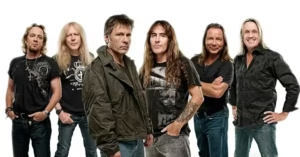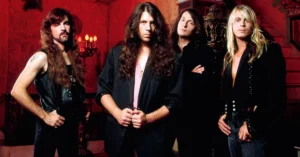Tool: The Architects of Psychedelic Metal Introspection
Tool. Formation and Musical Vision
Tool was formed in Los Angeles in 1990, emerging from the underground metal scene with a focus on complexity, mysticism, and catharsis.
Tool. Founding members:
- Maynard James Keenan – Vocals
- Adam Jones – Guitar
- Paul D’Amour – Bass (replaced by Justin Chancellor in 1995)
- Danny Carey – Drums
Tool’s early mission was to counter the simplicity and commercialism of mainstream rock by incorporating mathematical structures, altered time signatures, Carl Jungian psychology, sacred geometry, and transcendental meditation into their work.
They became known for:
- Opaque lyrics and themes
- Album-length concepts
- Surreal and disturbing music videos, often created by Jones (a former Hollywood FX artist)
II. Early Releases: Breaking Through with Depth (1991–1996)
✦ Opiate (1992, EP)
- Raw and aggressive; heavy alt-metal with anti-authority themes
- Tracks like “Hush” and “Part of Me” challenged censorship and conformity
- Gave Tool a dedicated underground following
✦ Undertow (1993)
- Their full-length debut, blending heavy riffs with progressive ambition
Key tracks:
- “Sober” – A haunting track about addiction and inner conflict
- “Prison Sex” – A disturbing meditation on cycles of abuse
- “Bottom” (featuring Henry Rollins)
The album went platinum, and Tool gained notoriety for their intense live shows and non-commercial stance in an era dominated by grunge.
III. Ænima (1996): Ascension Through Chaos
Tool’s second album, Ænima, is regarded as a milestone in alternative metal — a convergence of psychedelic, philosophical, and sonic depth.
Notable themes:
- Comedian Bill Hicks (credited on the album) as a spiritual muse
- Exploration of shadow psychology, alchemy, and human evolution
Essential tracks:
- “Stinkfist” – Commentary on media desensitization
- “Forty-Six & 2” – Based on Jung’s theory of human transformation
- “Ænema” – A satire about California’s collapse and spiritual cleansing
- “Pushit” – A slow-burning journey of emotional trauma and release
The album’s artwork, created with lenticular technology, symbolized the band’s unique fusion of art and music. It won a Grammy for Best Metal Performance (for “Ænema”).
IV. Lateralus (2001): The Philosophical Masterpiece
Lateralus marked Tool’s full evolution into progressive metal philosophers. It was heavier, more expansive, and spiritually profound.
Key elements:
- The title track follows the Fibonacci sequence, mirroring the golden ratio
- Lyrics explore spiral evolution, transcendence, and non-duality
Track highlights:
- “Schism” – Grammy-winning, known for its shifting time signatures and message of miscommunication
- “Parabol / Parabola” – A meditation on the illusion of the body and spiritual unity
- “The Grudge” – A lesson in letting go of emotional weight
- “Lateralus” – A call to break out of linear thinking and embrace the infinite
Lateralus debuted at #1 on the Billboard 200, further establishing Tool as intellectual giants in modern metal.
V. 10,000 Days (2006): Emotional Depth and Sonic Density
This album was more personal, particularly for Keenan, who addressed the death of his mother in the track “Wings for Marie” / “10,000 Days” — a 17-minute epic that combined mourning with theological inquiry.
Notable songs:
- “Vicarious” – A critique of society’s obsession with spectacle
- “The Pot” – A venomous attack on hypocrisy
- “Jambi” – A fusion of Middle Eastern rhythms and heavy groove
Despite polarized reviews, 10,000 Days sold well and became a cult favorite among Tool’s growing fanbase.
VI. Fear Inoculum (2019): A Return from the Void
After 13 years of silence, Tool returned with Fear Inoculum, an album that was both glacial and grand, exploring themes of aging, fear, rebirth, and awareness.
Notable tracks:
- “Fear Inoculum” – A slow-building mantra of resilience
- “Pneuma” – A hymn to the soul’s eternal nature
- “Invincible” – Reflecting on the aging warrior’s struggle for relevance
- “7empest” – A furious 15-minute finale that won the band another Grammy
The album debuted at #1 in the U.S., and its digital release was their first-ever appearance on streaming platforms, breaking records for physical/digital packaging artistry.
Tool. Visual and Artistic Identity
Tool is as much an art project as a band. Their visual aesthetic includes:
- Stop-motion, macabre music videos
- Album artwork by Alex Grey, featuring sacred geometry and psychedelic anatomy
- Live shows that prioritize visual immersion over band visibility
- A refusal to appear in their own videos or embrace media exposure
This has helped Tool maintain a mystique and intellectual aura unrivaled in modern rock.
Tool. Legacy and Influence
Tool is known for:
- Merging metal with art, mathematics, mysticism, and psychology
- Elevating the role of albums as full-length conceptual experiences
- Fostering a fiercely loyal fanbase through minimal exposure and maximum substance
Accolades:
- 4 Grammy Awards
- Millions of albums sold worldwide
- Universally praised for artistry, musicianship, and philosophical depth
Influenced:
- Mastodon, Karnivool, Gojira, The Contortionist
- A Perfect Circle (Keenan’s other band), Deftones, Riverside
- Progressive and alternative metal bands globally
Tool. Interesting Facts
- Danny Carey incorporates occult numerology and sacred geometry into his drumming patterns
- Maynard is also a winemaker (Caduceus Cellars in Arizona) and famously reclusive
- Tool once released a limited-edition video screen inside an album package (Fear Inoculum)
- The band is notoriously private, often avoiding interviews and media appearances
- They are one of the few bands where every member is considered virtuosic





